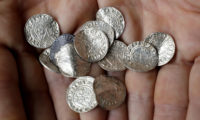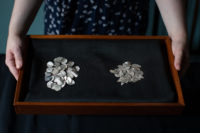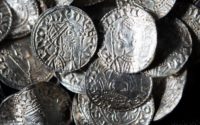 The largest hoard of coins from the immediate post-Norman Conquest period ever discovered has been unearthed in Somerset. It contains five times more coins bearing the head of William the Conqueror than the total number known to exist before the find. It is the largest Norman treasure of any kind found since 1833.
The largest hoard of coins from the immediate post-Norman Conquest period ever discovered has been unearthed in Somerset. It contains five times more coins bearing the head of William the Conqueror than the total number known to exist before the find. It is the largest Norman treasure of any kind found since 1833.
 It was discovered by metal detectorists Adam Staples and Lisa Grace in an unploughed field on a farm in Chew Valley, Somerset, this January. They were showing friends how to use their new equipment when the detector alerted them to the presence of the first coin, a silver penny of William the Conqueror. Over the next five hours, the three of them dug up thousands more. They put them in a bucket, notified the local finds liaison officer as required by law and drove them straight to the British Museum.
It was discovered by metal detectorists Adam Staples and Lisa Grace in an unploughed field on a farm in Chew Valley, Somerset, this January. They were showing friends how to use their new equipment when the detector alerted them to the presence of the first coin, a silver penny of William the Conqueror. Over the next five hours, the three of them dug up thousands more. They put them in a bucket, notified the local finds liaison officer as required by law and drove them straight to the British Museum.
 Most of the coins are silver pennies of William the Conqueror (r. 1066-1087) and the last Anglo-Saxon king of England Harold II (r. January 1066-October 14 1066). Harold’s reign was so short his coins are very rare. With more than a thousand of them found together in this hoard, it’s likely that there are coins in the mix that haven’t been seen before and even mint marks from previously unknown moneyers. There are also a half pennies (literally silver pennies cut in half) and a few coins bearing the portrait of Edward the Confessor (r. 1042- January 1066) that were part of a tax evasion scheme.
Most of the coins are silver pennies of William the Conqueror (r. 1066-1087) and the last Anglo-Saxon king of England Harold II (r. January 1066-October 14 1066). Harold’s reign was so short his coins are very rare. With more than a thousand of them found together in this hoard, it’s likely that there are coins in the mix that haven’t been seen before and even mint marks from previously unknown moneyers. There are also a half pennies (literally silver pennies cut in half) and a few coins bearing the portrait of Edward the Confessor (r. 1042- January 1066) that were part of a tax evasion scheme.
Gareth Williams, the [British M]useum’s curator of early medieval coinage, said the hoard of 2,528 coins was unusually large and “massively important” in shining light on the history of the period.
“One of the big debates amongst historians is the extent to which there was continuity or change, both in the years immediately after the conquest and across a longer period,” he said. “The coins help us understand how changes under Norman rule impacted on society as a whole.”
Three of the coins have been identified as “mules”, a combination of two types of coin – essentially an early form of tax-dodging by the moneyer, the person who made them.
These coins have designs and language that relate to both Harold and William, and would have been easy to pass off as legal tender as the average Anglo-Saxon was illiterate and the stylised images of the kings looked similar.
The hoard must have been buried before 1072, and probably just two or three years after the Norman Conquest of 1066. The value of the coins at that time would have been enough to buy 500 sheep, so a considerable amount of wealth. During those turbulent times, hiding portable wealth in a hole in the ground was the safe choice.
The coins are currently being assessed and catalogued by experts at the British Museum. A coroner’s inquest will be held to determine if the hoard qualifies as treasure under the terms of the Treasure Act of 1996. (It does, no question.) A treasure valuation committee will then determine fair market value for the coins. Museums will be given the opportunity to raise the amount of the assessed value which will be shared 50/50 by the finders and the landowner.
The bloke with the ‘aquiline‘ nose (i.e. hook nose) is Edward the Confessor while the other one is William? ..Where is Harald?
:hattip:
Dead, m’lord.
Brilliant!